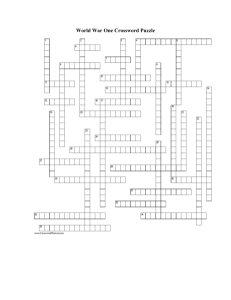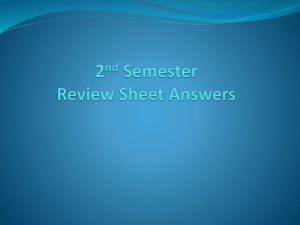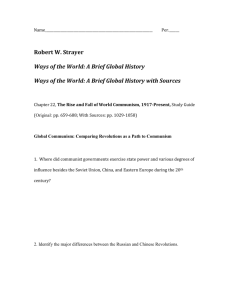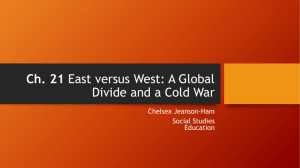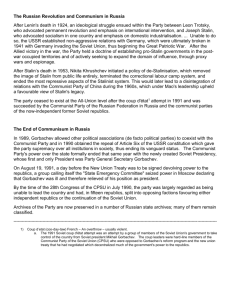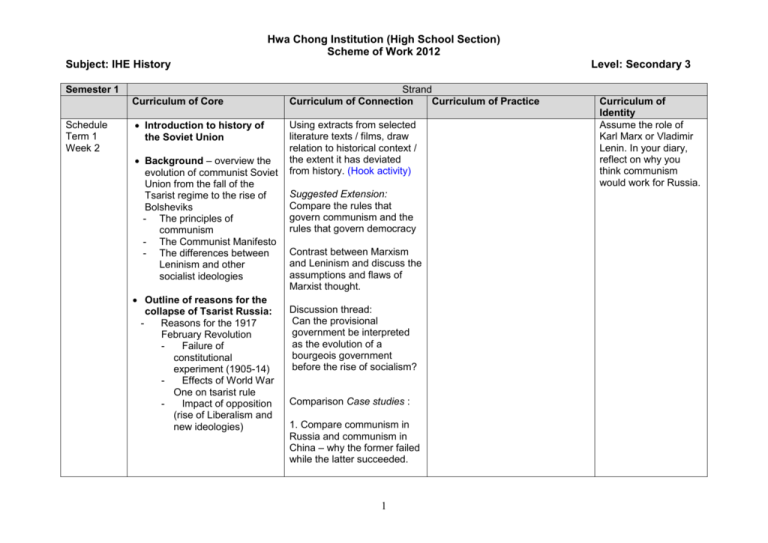
Hwa Chong Institution (High School Section)
Scheme of Work 2012
Subject: IHE History
Semester 1
Curriculum of Core
Schedule
Term 1
Week 2
Introduction to history of
the Soviet Union
Background – overview the
evolution of communist Soviet
Union from the fall of the
Tsarist regime to the rise of
Bolsheviks
- The principles of
communism
- The Communist Manifesto
- The differences between
Leninism and other
socialist ideologies
Outline of reasons for the
collapse of Tsarist Russia:
Reasons for the 1917
February Revolution
Failure of
constitutional
experiment (1905-14)
Effects of World War
One on tsarist rule
Impact of opposition
(rise of Liberalism and
new ideologies)
Level: Secondary 3
Strand
Curriculum of Connection
Curriculum of Practice
Using extracts from selected
literature texts / films, draw
relation to historical context /
the extent it has deviated
from history. (Hook activity)
Suggested Extension:
Compare the rules that
govern communism and the
rules that govern democracy
Contrast between Marxism
and Leninism and discuss the
assumptions and flaws of
Marxist thought.
Discussion thread:
Can the provisional
government be interpreted
as the evolution of a
bourgeois government
before the rise of socialism?
Comparison Case studies :
1. Compare communism in
Russia and communism in
China – why the former failed
while the latter succeeded.
1
Curriculum of
Identity
Assume the role of
Karl Marx or Vladimir
Lenin. In your diary,
reflect on why you
think communism
would work for Russia.
Hwa Chong Institution (High School Section)
Scheme of Work 2012
Subject: IHE History
Semester 1
Curriculum of Core
Level: Secondary 3
Strand
Curriculum of Connection
Curriculum of Practice
Curriculum of
Identity
2.Assess the role of leaders –
qualities of good leaders
Using case studies of current
communist countries. Have
the students find out how
long the country has
practised communism, who
are the communist leaders
who have run the country and
how the country currently
compares to other countries
with different political
systems. Research
population, economics and
political activism.
Processes
Products
(Assignment
s/
Tests )
Compare and contrast
Cause and effect
chronology of events
1. pre-lesson activity: map on
key regions and cities
2. Student- designed
worksheet on chronology of
events.
3. Lesson quiz: key events
4.
2
diary entry :
reflection on the
role of Karl Marx or
Vladimir Lenin.
Hwa Chong Institution (High School Section)
Scheme of Work 2012
Subject: IHE History
Semester 1
Curriculum of Core
Environment
Individual
Collaborative learning
Level: Secondary 3
Strand
Curriculum of Connection
Curriculum of Practice
Curriculum of
Identity
Collaborative groups
Resources
Core references :
Oxley, Peter Russia 1855-1991 From Tsars to Commissars (Oxford University Press, 2001) pp.12-21
Lowe, Norman Mastering 20th century Russian History (Palgrave, 2002)+ Lowe, Norman Mastering Modern World History (Palgrave,
1997);
Walsh, Ben GCSE Modern World History (John Murray, 2001);
Others
Kelly, Nigel and Shuter, Jane As It Was Lived (Pearson Longman, 2007)
Ali, Tariq and Evans Phil, Introducing Trotsky and Marxism (Totem Books, 2000) pp. 25, 41-48.
Robinson, Dave and Groves, Judy Introducing Political Philosophy (Totem Books, 2003) pp. 90-91, 114-125
Appignanesi Richard and Zarate Oscar, Introducing Lenin, (Totem Books, 2000)
Related literature texts, e.g. Animal Farm
http://www.johndclare.net/Russ1.htm
http://en.internationalism.org/icconline/2006/december/what-is-communism
http://articles.gourt.com/en/Communist
http://marxistleninist.wordpress.com/intro-to-ml/
http://www.newyouth.com/archives/marxisttheory.asp
http://www.wpunj.edu/~newpol/issue24/robeso24.htm
http://www.marx2mao.com/Lenin/SR17.html
Schedule
Term 1
Week 2
Unit 1: Establishment and
consolidation of Communist
rule:
Draw parallels between
success of revolutions in
Russia with other revolutions,
e.g. 1911 revolution in China.
3
Welfare of the people vs idealism
(caring thinking)
Assume the role of leaders,
e.g. the ‘Big Three’ (Woodrow
Students will be
tasked to correlate
elements of
Marxist and
Hwa Chong Institution (High School Section)
Scheme of Work 2012
Subject: IHE History
Semester 1
Curriculum of Core
The 1917 October
revolution :
- Reasons for Bolshevik
success
- Weaknesses/ineffectivene
ss of the Provisional
Government
Schedule
Term 1
Week 3-5
Lenin’s RussiaEstablishment of Bolshevik
rule, 1917-24
Level: Secondary 3
Strand
Curriculum of Connection
Curriculum of Practice
Suggested extensions:
Draw parallels of the rise of
people power, e.g. China and
Vietnam.
Compare to Singapore’s
principles of governance (role
of the government)
1. Creation of the first
Communist state
- Domestic reform
- Dissolution of the
Constituent Assembly
- Peace negotiations –
Treaty of Brest-Litovsk
- Creation of the Red Army
- The First Soviet
Constitution
2. Bolshevik victory in the
Civil War, 1918-21
3. Economic policies
- War Communism
- The New Economic Policy
4
Wilson, Georges Clemenceau
and Lloyd George). Reflect on
how personal experience and
power affect the decisions in
the making of the Treaty of
Versailles.
Suggested ACE activity :
Recreate any part of this topic
through graphic illustration, for
example, a comic strip of the
success of the Red Army.
Curriculum of
Identity
Leninist theories
with the practical
policies
implemented
during War
Communism and
NEP.
Hwa Chong Institution (High School Section)
Scheme of Work 2012
Subject: IHE History
Semester 1
Curriculum of Core
Level: Secondary 3
Strand
Curriculum of Connection
Curriculum of Practice
Suggested Discussion thread :
Lenin a realist or opportunist?
To what extent did Lenin’s rule
exemplify communist features?
Processes
(include
pedagogies
and indicate
infusion of
ICT)
Products
Key concepts:
Socialist Revolutionaries
Mensheviks
Bolsheviks
World Revolution
Socialism in One Country
Continuity and change
Compare and contrast
Cause and consequences.
Blended learning activity that
focuses on writing effective
conclusion through peer
evaluation.
1. essay practice exercise
5
Curriculum of
Identity
Hwa Chong Institution (High School Section)
Scheme of Work 2012
Subject: IHE History
Semester 1
Curriculum of Core
(Assignment
s/
Tests)
Environment
Level: Secondary 3
Strand
Curriculum of Connection
Curriculum of Practice
Curriculum of
Identity
2. Term 1 Test : structuredessay question
Collaborative groups
Group work
Resources
McCauley, Martin. (2nd Ed.). 1993. The Soviet Union 1917-1991. Longman.
Robottom, John. 1993. Modern Russia. Longman.
Chase, Marilyn. Russia. A Milliken Full-Color Transparency Book. Milliken Publishing Co. St Louis, Missouri.
Schedule
Term 1
weeks 6-10
Blended
learning
Unit 2: The Stalin Era
Rise of Stalin – Reasons for
triumph over Trotsky
Building of the Stalinist
totalitarian state
1. Political policies
- use of terror
- use of propaganda & cult
of personality
Propaganda and
Censorship : compare with
North Korea – Kim Jong II
(totalitarian rule)
Censorship – compare with
Singapore
2. Economic policies
a. GOSPLAN
b. Industrialization: 5-Year
Plans (industrialization
c. collectivisation
6
Students assume different roles in
courts (e.g. the accused, the jury,
barrister, the witness(es) etc.) and
conduct a mock trial of Stalin’s
crimes.
Students reflect and
understand how they
themselves may
harbor biases.
Suggested ACE activity :
Do a poster that is aimed to win
support for Stalin during the purges
Though labeled as an
evil rule, identify any
aspect of Stalin’s
leadership and how it
can be used as
positive leadership
quality.
Hwa Chong Institution (High School Section)
Scheme of Work 2012
Subject: IHE History
Semester 1
Curriculum of Core
Level: Secondary 3
Strand
Curriculum of Connection
Curriculum of Practice
3. Impact of Stalin’s rule on
Russia and its people
Processes
(include
pedagogies
and indicate
infusion of
ICT)
Products
(Assignment
s/
Tests/
Practicals)
Causes and consequence
Role play
Blended learning – SBQ
self/peer evaluation
Environment
Collaborative groups
Individual work
Suggested discussion threads:
Can Stalin be considered the
bearer of communism?
Discussion thread : Stalinism
and Fascism: a comparative
analysis.
Must Communism be
authoritarian?
Suggested ace :
Based on a communist
country, students design
poster reflecting propaganda
message(s) infused and
accompanied by a write-up
and reflection.
Resources
Murphy, Derrick and Morris, Terry, Russia 1955-1964, (HarperCollins, 2008) pp. 130-159
1. http://articles.gourt.com/en/Stalinism
2. http://www.newyouth.com/archives/theory/russian_revolution.asp
3. http://www.internationalist.org/stalinismandbolshevism.html
http://www.appstate.edu/~brantzrw/history3134/stalinist.html
7
Curriculum of
Identity
Hwa Chong Institution (High School Section)
Scheme of Work 2012
Subject: IHE History
Semester 1
Curriculum of Core
Schedule
Term 2
Weeks 1-3
Unit 3: Challenges to Soviet
power
The Khrushchev Era
(1953-64)
-
Processes
(include
pedagogies
and indicate
infusion of
ICT)
Products
(Assignment
s/
Tests )
Environment
Level: Secondary 3
Strand
Curriculum of Connection
Curriculum of Practice
assessing the society's
problems in various
categories/perspectives
(using Paul’s Wheel of
reasoning)
Stagnation of Soviet Power
(1964-85)
The Hungarian Revolution
Polish reforms
Bureaucratic centralism
versus socialism with a
human face: Dubcek, the
Prague Spring, and the
Warsaw Pact invasion of
Czechoslovakia.
Compare and contrast
Cause and effect
Paul’s Wheel of reasoning
1. group sharing : reflection on
personal experience and how
school values can be applied
Collaborative groups
8
assess the impact of Moscow
central control over eastern
Europe :
- students to put themselves in the
shoes of the Eastern Europeans suggest how they might feel to be
under close control and what they
might do to liberate themselves.
Curriculum of
Identity
Students reflect on
how the school values
- integrity, excellence
& resilience can be
applied using their
own personal
experience.
Hwa Chong Institution (High School Section)
Scheme of Work 2012
Subject: IHE History
Semester 1
Curriculum of Core
Level: Secondary 3
Strand
Curriculum of Connection
Curriculum of Practice
Curriculum of
Identity
Resources
1.
2.
3.
4.
5.
6.
7.
Strayer, Robert. 1998. Why Did Soviet Union Collapse? Understanding History Change. M.E. Sharpe Armonk, New York, London,
England.
Hosking, Geoffrey. 1992. A History of the Soviet Union. 1917-1991. Fontana Press.
Hosking, Geoffrey. 1992. A History of the Soviet Union. 1917-1991. Fontana Press.
Murphy, Derrick and Morris, Terry, Russia 1955-1964, (HarperCollins, 2008) pp. 160-170.
White Stephen, Communism and its Collapse, (Routledge, 2001)
http://www.lrp- cofi.org/PR/gorbachev27.html
http://www.marxists.org/archive/cliff/works/1955/statecap/postscript.htm
http://www.uvm.edu/~hst19/Online_Reading/Lecture_11.htm
http://www.fordham.edu/halsall/mod/modsbook50.html#Eastern Europe Since 1945
http://www.mises.org/story/3105
http://www.newyouth.com/archives/marxisttheory.asp
http://www.wpunj.edu/~newpol/issue24/robeso24.htm
Schedule
Term 2
weeks 4-6
Unit 4: Gorbachev and the end
of communist rule
Gorbachev’s policies of
perestroika and glasnost:
Impact of Gorbachev’s
reforms –
- The Sovietization of
Eastern Europe
- Results and implications
of perestroika and
Suggested extension:
Comparison study : Explain
why China’s model of
modernization is more
successful than the Soviet
Union’s.
Assume the role of PolicyManagement committee members.
Debate on : Which should come
first? Perestroika or Glasnost?
Suggested ACE activity :
Assume the role of a political party
leader and write a speech for the
upcoming elections in USSR
Journal Reflections on
Gorbachev :
As Gorbachev, reflect
on your considerations
and dilemma that
made you decide to
implement perestroika
and glasnost.
Identify Gorbachev’s
reforms and relate
9
Hwa Chong Institution (High School Section)
Scheme of Work 2012
Subject: IHE History
Semester 1
Curriculum of Core
Level: Secondary 3
Strand
Curriculum of Connection
Curriculum of Practice
glasnost on the Eastern
European countries
(Eastern Bloc)
Curriculum of
Identity
them to our school
values.
Discussion thread:
Can Communist Russia be
reformed without
compromising Communist
theory?
Key Concepts:
Perestroika
Glasnost
Processes
(include
pedagogies
and indicate
infusion of
ICT)
Discussion thread :
‘Glasnost’ = transparency (relate
to principles of governance)
Consider the degree of
transparency a country should
have in protecting its integrity.
Products
(Assignment
s/
Tests/
Practicals)
Interactive Computer Based
Lesson: Crisis in Kremlin
source-based skills practice to
develop critical thinking : Primary
/ and secondary sources
to examine the different
perspectives of the leadership of
Suggested ACE
activity: students
design worksheet
testing different skills
of source-based
10
Hwa Chong Institution (High School Section)
Scheme of Work 2012
Subject: IHE History
Semester 1
Curriculum of Core
Level: Secondary 3
Strand
Curriculum of Connection
Curriculum of Practice
Gorbachev.
Environment
Collaborative groups
Group work
Individual / pair work
Resources
Resources:
Norman Lowe, ‘Mastering Modern History’, Macmillian, 4th Ed, 2005
Ben Walsh, ‘Modern World History’, John Murray publisher, 2nd Edition, 2001.
Nigel Kelly,’The Modern World’, Heinemann publishing, 1999.
Issacs Jeremy & Downing Taylor, ‘Cold War’, Bantam Press, 1998.
Oxley Peter, ‘Russia: 1855-1991From Tsars to Commissars’, Oxford University Press, 2001.
1. http://www.lrp-cofi.org/PR/gorbachev27.html
1.
2.
3.
4.
5.
2. http://www.marxists.org/archive/cliff/works/1955/statecap/postscript.htm
3. Interactive Computer Simulation: Crisis in the Kremlin (Spectrum Holobyte Inc, 1991)
4. CNN: Cold War (8pc) [VCD] (1998), Starring: Kenneth Branagh, Director: Tessa Coombs
5. Heaven on Earth: The Rise and Fall of Communism, http://www.pbs.org/heavenonearth/teachers.html
6. Discovery Education movie clips, http://www.discoveryeducation.com/
7. http://www.fordham.edu/halsall/mod/modsbook50.html#The Soviet Union/Russia
8. http://hi5tory.com/exams2010/
Relate students’
Role play in a newscast of the
11
Curriculum of
Identity
question based on a
related issue.
Hwa Chong Institution (High School Section)
Scheme of Work 2012
Subject: IHE History
Semester 1
Curriculum of Core
Schedule
Term 2
week 7
Processes
(include
pedagogies
and indicate
infusion of
ICT)
Products
(Assignment
s/
Tests/
Practicals)
Events leading to the
collapse of the Soviet
Union
Coup of August 1991
Consequences of failed
coup : disgrace of the
communist party;
resignation of Gorbachev
as party general
secretary, increasing
prominence of Boris
Yeltsin etc.
Creation of CIS
(Commonwealth of
Independent States) –
successor of USSR
Level: Secondary 3
Strand
Curriculum of Connection
Curriculum of Practice
understanding of the
concept of nationalism to a
possible cause for the failure
of communism.
Test
Cause and consequences
Problem solving
Paul’s wheel of reasoning
Blended learning
1. source-based practice
exercise
2. Term 2 Test :source-based
question.
12
1956 Revolutions.
Curriculum of
Identity
Hwa Chong Institution (High School Section)
Scheme of Work 2012
Subject: IHE History
Semester 1
Curriculum of Core
Environment
Level: Secondary 3
Strand
Curriculum of Connection
Curriculum of Practice
Curriculum of
Identity
Collaborative groups
Individual work
Resources
Film: Goodbye Lenin
http://www.idee.org/cubaideas4.html
http://www.appstate.edu/~brantzrw/history3134/sovietcollapse.html
http://web.ku.edu/~eceurope/hist557/index.htm
http://chnm.gmu.edu/1989/
http://www.cs.hmc.edu/~kknudtzo/portfolio/papers/EastEurope.html
http://nhs.needham.k12.ma.us/cur/Baker_00/2001_p6/baker_jl_al_sh_p6/solidarity.htm
http://www.historyguide.org/europe/lecture16.html
http://www.cla.wayne.edu/polisci/kdk/easteurope/sources/schopflin2.htm
1960. The conscience of the revolution: Communist opposition in Soviet Russia. Cambridge, Mass.: Harvard University Press
Service, Robert. 1997. A History of 20th century Russia. Cambridge, Mass.: Harvard University Press
Schedule
Term 2
Weeks 9-10
Revision and exam
13
Hwa Chong Institution (High School Section)
Scheme of Work 2012
Subject: IHE History
Tests:
No. of class test per term: 1
Duration of class test: 50 min
Level: Secondary 3
No. of class tests per year: 2
Format of class test paper:
Note :
Either source-based question or structured essay will be tested for each test.
By the end of Term 2, BOTH source-based question and structured essay MUST be tested.
Source-based question [25m]
(a) inference (simple / higher level targeting at message / purpose)
(b) comparison
(c) reliability
(d) usefulness
structured-essay question [25m]
(a) explanation, e.g. Was X the main reason…(12m)
(b) judgemental, e.g. How far / To what extent / How successful / How important etc…. (13m)
14

